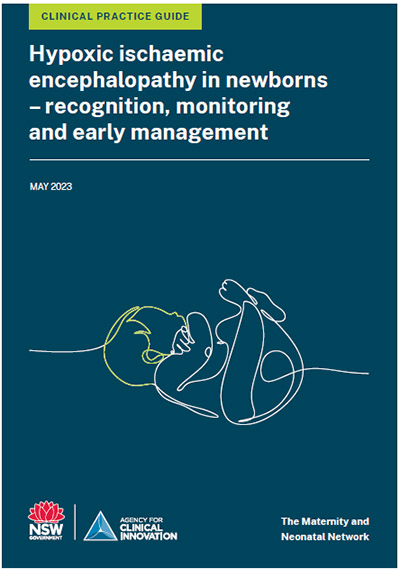
Published: June 2024. Next review: 2029.
This clinical practice guide provides guidance on recognition, monitoring and early management of newborns with hypoxic ischaemic encephalopathy (HIE) who may benefit from therapeutic hypothermia (cooling). It replaces the NSW Health Policy Directive PD2010 006: Whole Body Cooling – Neonates Suspected Moderate or Severe Hypoxic Ischaemic Encephalopathy (HIE).
The guide contains:
- general principles of management of newborns at risk of HIE
- clinical management of newborns with HIE
- care of the family
- reporting processes.
Tools for clinicians included in the guide:
- Newborn Encephalopathy Pathway
- Newborn Encephalopathy Assessment Tool
- Therapeutic Hypothermia (‘Cooling’) Pathway
- Reporting process for newborns with moderate or severe encephalopathy.
Download the clinical practice guide (PDF 668.0 KB)
Parent information sheet: Therapeutic hypothermia (cooling) to protect babies with HIE
Published: May 2023. Next review: 2028.
This information sheet answers the questions that parents may have about therapeutic hypothermia and how it is used to care for babies with HIE. It also lists the resources that parents may be able to access to get support for themselves and their newborn. Clinicians are encouraged to share this information sheet with parents.
Download the parent information sheet (PDF 152.9 KB)
Therapeutic hypothermia in neonatal hypoxic ischemic encephalopathy - evidence check
Published: April 2021.
Evidence has found therapeutic hypothermia to be safe for term and late preterm infants (≥35 weeks gestation) with moderate or severe HIE.
A rapid evidence check was conducted to investigate if therapeutic hypothermia should be commenced in:
- newborns with mild HIE
- newborns diagnosed with HIE after six hours after birth.
Evidence was also reviewed to find out if therapeutic hypothermia should be continued for >72 hours.
The findings from the evidence check informed the guidance in the clinical practice guide.